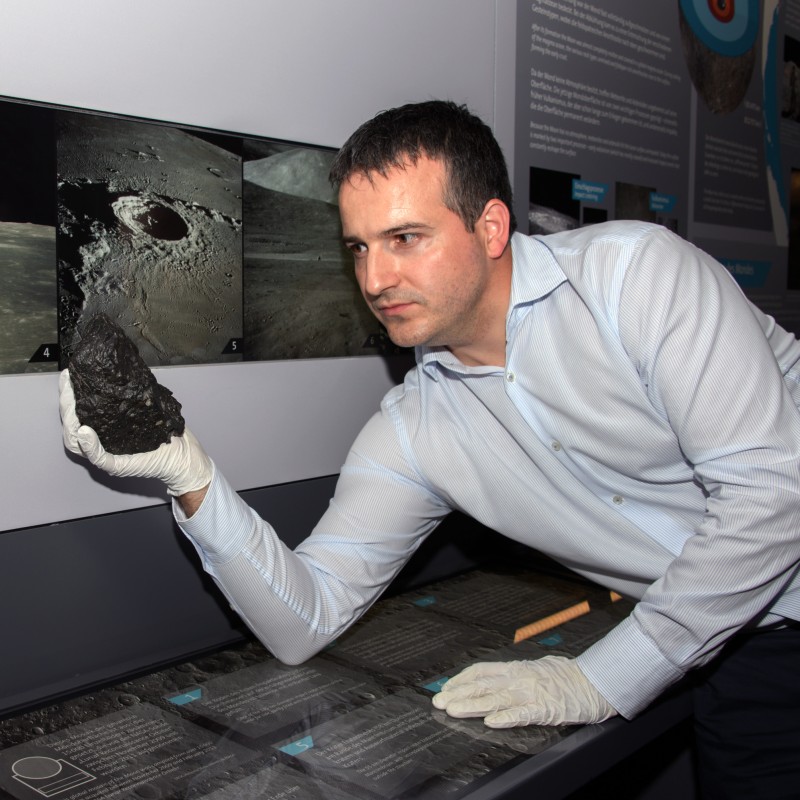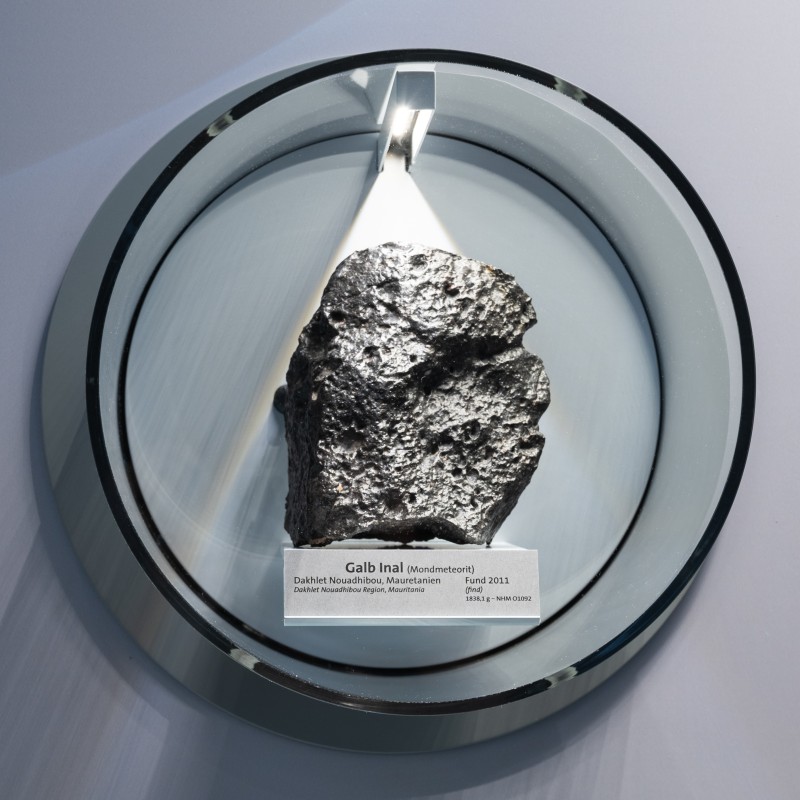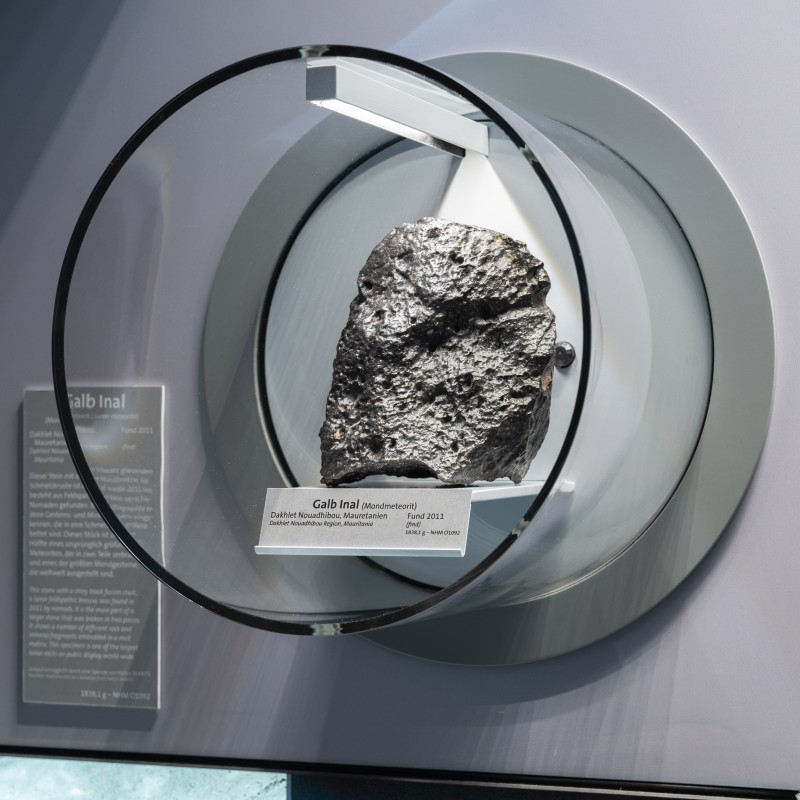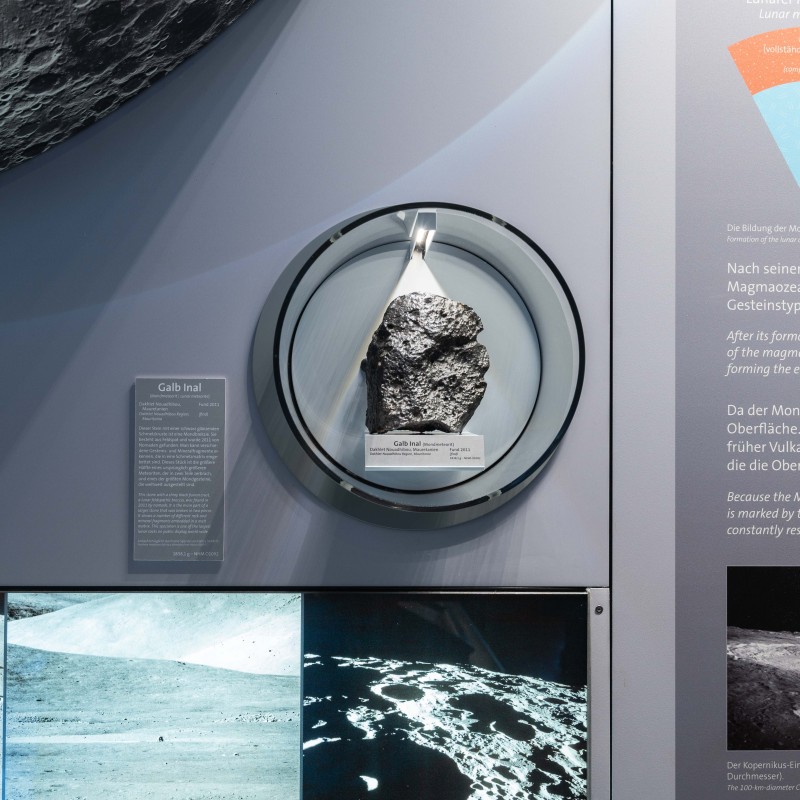One of the world largest lunar meteorites now on display at the Natural History Museum Vienna
18. August 2020
The lunar meteorite "Galb Inal" is now on display in the meteorite hall of the NHM Vienna, thanks to a testamentary donation.
Weighing 2 kg, the meteorite is one of the largest pieces of the Moon in a public display worldwide.
The
lunar meteorite "Galb Inal" was recently added to the collection of the NHM Vienna and is now on display in hall 5 ("meteorite
hall") of the Museum. It was ejected from the Moon during an impact event, reached the Earth's surface and was finally found
by Nomads in Mauritania in 2011. The meteorite specimen represents half of the original meteorite which was broken in two
pieces. The other part of the meteorite was sliced and acquired by a number of private meteorite collectors. A small fraction
of it was used for scientific investigations. The meteorite is named "Galb Inal" after the closest village where it was found.
It is a lunar feldspathic breccia with a shiny black wind polished surface. The specimen shows a number of different rocks
and mineral fragments embedded in a melt matrix.
Some results of the investigation of this meteorite were published in 2020 by Dr. Ludovic Ferrière, curator of the meteorite and impactite collections at NHM Vienna, Dr. Christian Koeberl (now at the University of Vienna), and colleagues from the Comenius University in Bratislava (Slovakia). In this publication it is shown that the Galb Inal meteorite originally had a diameter comprised between 18 and 26 cm and a mass comprised between 7 and 23 kg before entering the Earth's atmosphere. Only 4.05 kg made it to the ground after several kilos were lost during the atmosphere entry. The specimen on display at the NHM Vienna weighs 1838.1 g and is 13 x 10.5 x 9.5 cm in size. It is one of the largest lunar rocks on public display world-wide! The meteorite is presented in a showcase next to the unique display of three Apollo specimens on loan from NASA.
It was only in 1982 that the first lunar meteorite was found and recognized based on similar characteristics as the rock samples from the Apollo missions. Altogether, eleven different lunar meteorites are represented in the NHM Vienna collection while more than 400 different lunar meteorites are known. "The study of lunar meteorites not only helps to better understand the Moon, but also our own Earth," says Dr. Ludovic Ferrière in an interview on the relevance of lunar meteorites for science.
The acquisition of this valuable meteorite by the NHM Vienna was possible thanks to a generous donation from Hatice Skarits (1930-2016). The Viennese amateur astronomer was a big fan of the Natural History Museum Vienna and she wrote in her will that the museum should acquire a meteorite for the meteorite hall using her inheritance. The NHM Vienna succeeded in acquiring the lunar meteorite "Galb Inal".
To the scientific articles:
Povinec P. P., Sýkora I., Ferrière L., and Koeberl C. 2020. Analyses of radionuclides in the Oued Awlitis 001 and Galb Inal lunar meteorites by HPGe gamma-ray spectrometry. Journal of Radioanalytical and Nuclear Chemistry 324(1):349–357.
https://link.springer.com/article/10.1007/s10967-020-07034-7
https://www.lpi.usra.edu/meteor/metbull.php?code=63095
More information about the meteorite collection:
https://www.nhm-wien.ac.at/en/research/mineralogy__petrography/collections/the_meteorite_collection
Donations from private donors such as Hatice Skarits allow the Natural History Museum Vienna to expand the collections and also to support scientific projects.
For more information on how to support the NHM Vienna:
https://www.nhm-wien.ac.at/en/museum/sponsors/supporting_the_nhm_vienna
Some results of the investigation of this meteorite were published in 2020 by Dr. Ludovic Ferrière, curator of the meteorite and impactite collections at NHM Vienna, Dr. Christian Koeberl (now at the University of Vienna), and colleagues from the Comenius University in Bratislava (Slovakia). In this publication it is shown that the Galb Inal meteorite originally had a diameter comprised between 18 and 26 cm and a mass comprised between 7 and 23 kg before entering the Earth's atmosphere. Only 4.05 kg made it to the ground after several kilos were lost during the atmosphere entry. The specimen on display at the NHM Vienna weighs 1838.1 g and is 13 x 10.5 x 9.5 cm in size. It is one of the largest lunar rocks on public display world-wide! The meteorite is presented in a showcase next to the unique display of three Apollo specimens on loan from NASA.
It was only in 1982 that the first lunar meteorite was found and recognized based on similar characteristics as the rock samples from the Apollo missions. Altogether, eleven different lunar meteorites are represented in the NHM Vienna collection while more than 400 different lunar meteorites are known. "The study of lunar meteorites not only helps to better understand the Moon, but also our own Earth," says Dr. Ludovic Ferrière in an interview on the relevance of lunar meteorites for science.
The acquisition of this valuable meteorite by the NHM Vienna was possible thanks to a generous donation from Hatice Skarits (1930-2016). The Viennese amateur astronomer was a big fan of the Natural History Museum Vienna and she wrote in her will that the museum should acquire a meteorite for the meteorite hall using her inheritance. The NHM Vienna succeeded in acquiring the lunar meteorite "Galb Inal".
To the scientific articles:
Povinec P. P., Sýkora I., Ferrière L., and Koeberl C. 2020. Analyses of radionuclides in the Oued Awlitis 001 and Galb Inal lunar meteorites by HPGe gamma-ray spectrometry. Journal of Radioanalytical and Nuclear Chemistry 324(1):349–357.
https://link.springer.com/article/10.1007/s10967-020-07034-7
https://www.lpi.usra.edu/meteor/metbull.php?code=63095
More information about the meteorite collection:
https://www.nhm-wien.ac.at/en/research/mineralogy__petrography/collections/the_meteorite_collection
Donations from private donors such as Hatice Skarits allow the Natural History Museum Vienna to expand the collections and also to support scientific projects.
For more information on how to support the NHM Vienna:
https://www.nhm-wien.ac.at/en/museum/sponsors/supporting_the_nhm_vienna





